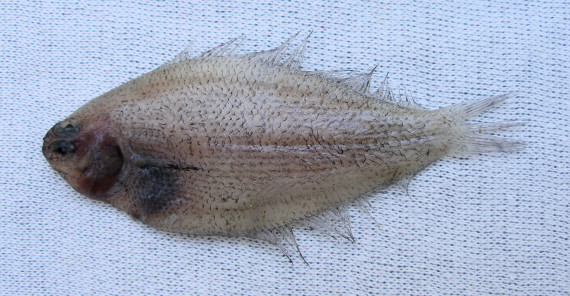Peruvian Flounder, Etropus peruvianus
 Peruvian Flounder, Etropus peruvianus. Fish provided by the commercial fishermen in the greater Los Cabos area, Baja California Sur, September 2011. Length: 7.0 cm (2.75 inches).
Peruvian Flounder, Etropus peruvianus. Fish provided by the commercial fishermen in the greater Los Cabos area, Baja California Sur, September 2011. Length: 7.0 cm (2.75 inches).
The Peruvian Flounder, Etropus peruvianus, is a member of the Sand Flounder or Paralichthyidae Family, and is known in Mexico as lenguado zapatilla. Globally there are nine members of the genus Etropus, of which five are found in Mexican waters, two in the Atlantic Ocean, two in the Pacific Ocean, and one in both the Atlantic and the Pacific Oceans.
The Peruvian Flounder is a flatfish has an elongated oval body with a depth that is 40% to 44% of standard length. Their eye side is tan in color with a large dark blotch behind their gill cover that extends back along their lower flank behind the pectoral fins. Their fins are paler than the body and the outer third of their pectoral fins is dark. Their blind side is off-white. They have a short blunt head with a short small mouth that reaches the front edge of their medium-sized eyes. Their eyes are on the left side, set close together and parallel. Their anal fin has 62 to 68 rays; their caudal fin has a blunt angular point; their dorsal fin has 79 to 86 dorsal rays; their pectoral fins are 75 to 85% of head length; and, their pelvic fins originate mid-body. They have 5 to 9 gill rakers on their lower arch. They are covered with small rough scales and their lateral line is straight and originates at the top corner of their gill cover.
The Peruvian Flounder is a demersal species that are found over and within sandy and muddy bottoms at depths up to 46 m (150 feet). They reach a maximum of 12.3 cm (4.8 inches) in length, as established by a fish that I collected. They are opportunistic and well-camouflaged ambush predators that lie in wait half submerged on the ocean floor. The Peruvian Flounder is poorly studied with very limited information available about their lifestyle and behavioral patterns including specific details on age, growth, longevity, movement patterns, diet, habitat use, and reproduction.
The Peruvian Flounder is a resident of all Mexican waters of the Pacific Ocean with the exception that they are absent from Magdalena Bay, Baja California Sur northward along the central and northwest coasts of Baja.
The Peruvian Flounder can be confused with the Fringed Flounder, Etropus crossotus, and the Intermediate Flounder, Etropus ciadi, but both have body depths greater than 50% of standard length.
From a conservation perspective the Peruvian Flounder is currently considered to be of Least Concern with stable, widely distributed populations. although fairly common in some locations, are too small in stature to be of interest to most. They are caught with some frequency as a by-catch of deep water shrimp trawlers.
